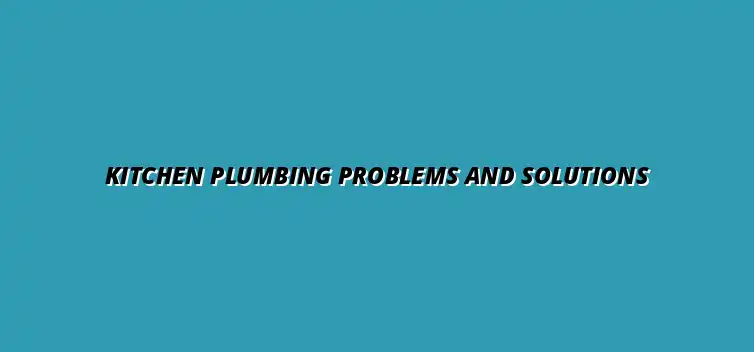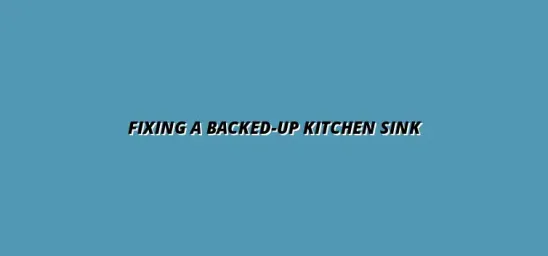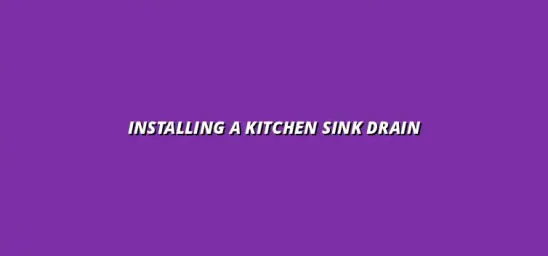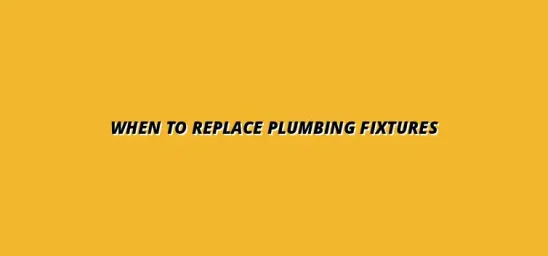
Kitchen Plumbing Problems and Solutions
Understanding Common Kitchen Plumbing Challenges
Kitchen plumbing issues can be a real headache! Many homeowners face challenges that can range from minor annoyances to significant problems. Understanding these common plumbing challenges is the first step in addressing them effectively and ensuring your kitchen runs smoothly.
Identifying Major Kitchen Plumbing Issues
It's essential to recognize the key issues that can affect your kitchen plumbing. By identifying these problems early, you can often prevent more serious damage down the road. Here are some of the major plumbing issues you might encounter:
- Leaky Faucets - These can waste a lot of water over time!
- Clogged Drains - A common issue that can lead to unpleasant odors and backups. For help unclogging your drains, check out these easy drain unblocking tips.
- Running Toilets - They can significantly increase your water bill without you even noticing.
- Low Water Pressure - It can make simple tasks, like washing dishes, frustrating.
Leaky Faucets and Their Implications
Leaky faucets are more than just a nuisance; they can lead to bigger problems if not addressed. Over time, leaks can cause water damage to your cabinetry and flooring. Plus, you might be shocked at how much water gets wasted—approximately 3,000 gallons a year!
Fixing a leaky faucet promptly can save you money on your water bill and protect your kitchen’s aesthetics. For help repairing a leaky kitchen sink, you can find guidance here. If you notice a constant drip, it's best to take action before it worsens.
Clogged Drains: Causes and Effects
Clogged drains are a common kitchen dilemma. They can be caused by food scraps, grease buildup, or even foreign objects accidentally dropped in. If you're struggling with a clogged kitchen sink, this guide on fixing a clogged kitchen sink can help. If left unchecked, clogged drains can lead to unpleasant odors and may even cause flooding!
- Food Waste: Scraps should never go down the drain.
- Grease: This can harden and block pipes.
- Hair and Soap Residue: These can create tough clogs in sinks.
Running Toilets and Their Impact on Water Bill
Running toilets can be sneaky culprits when it comes to increased water bills. If you hear your toilet running constantly, it might be worth checking. The average household can waste up to 200 gallons of water a day due to this issue!
Not only does it inflate your bill, but it can also signify issues with the toilet's components. Addressing this promptly can save you money and help you avoid potential water damage in the bathroom.
Low Water Pressure: Symptoms and Sources
Low water pressure can be frustrating, especially when washing dishes or rinsing vegetables. If your water pressure seems lower than usual, it could be due to several reasons, such as mineral buildup, pipe leaks, or issues with the municipal supply. For simple solutions to boost your water pressure, check out this helpful guide: Fix Low Water Pressure Easily.
- Mineral Buildup: Hard water can lead to deposits in faucets.
- Pipe Leaks: They can divert water flow, leading to lower pressure.
- Municipal Issues: Sometimes, the problem lies with your water provider.
Common Causes of Kitchen Plumbing Problems
Understanding what causes kitchen plumbing problems is crucial for prevention. Many issues stem from everyday use and environmental factors. Here are some common causes:
- Age and Wear of Plumbing Fixtures: Older fixtures might be more prone to leaks.
- Improper Installation Practices: Poorly installed pipes can lead to future headaches.
- Environmental Factors: Weather can impact plumbing, especially in cold climates.
- Usage Patterns: Heavy usage can lead to wear and tear.
Age and Wear of Plumbing Fixtures
As plumbing fixtures age, they can become more susceptible to leaks and inefficiency. Regular maintenance is essential to ensure they remain in good working order. For helpful plumbing maintenance tips, visit this page. If your fixtures are over ten years old, it might be time to consider replacements!
Keeping an eye on them can save you from larger plumbing emergencies. Plus, upgrading to newer models often means using less water, which is great for both your wallet and the environment.
Improper Installation Practices
If plumbing was not correctly installed, it could lead to a series of issues over time. Poorly fitted pipes or inadequate sealing can cause leaks, which can escalate into significant problems if not addressed. Always ensure that installations are performed by qualified professionals. For plumbing installation and repair in Billesley, Birmingham, you can contact a local plumber here.
Being vigilant about installation can save you on repairs down the line. If you're dealing with a new home, it's worth checking the plumbing work that has been done!
Environmental Factors Affecting Plumbing
Environmental elements, such as temperature changes and humidity, can affect your plumbing system. Cold weather can cause pipes to freeze and burst, while humidity can lead to mold and mildew. Being mindful of these factors will help in caring for your plumbing.
- Temperature Fluctuations: Can cause pipes to expand and contract.
- Humidity Levels: High humidity can lead to mold growth.
- Soil Movement: Shifts in soil can impact underground pipes.
Usage Patterns Leading to Plumbing Issues
Your usage patterns can significantly impact the health of your plumbing system. Frequently putting food scraps down the sink or flushing inappropriate items can lead to clogs and other issues. Being mindful of what goes down your drains is crucial.
Establishing good habits, like using sink strainers and teaching family members about proper usage, can help maintain your plumbing system. Simple changes in behavior can prevent costly repairs!
Signs You Might Have a Plumbing Issue in Your Kitchen
Recognizing the signs of plumbing issues can prevent minor annoyances from turning into major disasters. Here are some indicators that something might be amiss:
- Visual Indicators: Such as water stains or mold.
- Auditory Cues: Strange noises from pipes.
- Water Bill Anomalies: A sudden increase in your bill.
Visual Indicators: What to Look For
Look for visible signs of plumbing issues in your kitchen. Water stains on the ceiling or walls can indicate leaks. If you notice mold growth around sinks or under cabinets, it’s a clear sign that moisture is lingering.
Regularly checking for these visual cues can save you a lot of trouble in the future. The sooner you can identify a problem, the easier it is to fix it!
Auditory Cues: Sounds of a Plumbing Problem
Listening closely can help you identify plumbing issues early. For example, if you hear dripping sounds or gurgling noises, it might be a sign of a clog or leak. Take note of any unusual sounds and investigate them promptly!
Sometimes, a little investigation can reveal a problem before it escalates. Trust your instincts if something doesn’t sound right!
Water Bill Anomalies: When to Investigate
Your water bill can be a great indicator of plumbing issues. If you notice a sudden spike in your bill without a clear reason, it’s time to check for leaks or running toilets. Tracking your bill regularly can help you catch issues early!
- Compare Monthly Bills: Look for significant changes.
- Monitor Usage: Keep track of your daily water use.
- Investigate Unexplained Increases: Don’t ignore sudden jumps.
Preparation for DIY Plumbing Repairs
Before diving into any DIY plumbing repairs, it’s essential to be well-prepared. Having the right tools and understanding safety precautions can make your experience much smoother. Here are some things to consider:
- Essential Tools: Make sure you have what you need.
- Safety Precautions: Always prioritize your safety!
Essential Tools for Kitchen Plumbing Repairs
Having the right tools can make all the difference when tackling plumbing repairs. Essential tools include:
- Wrench: For tightening or loosening pipes.
- Plunger: A must-have for clearing clogs!
- Pipe Tape: Helps prevent leaks.
- Screwdrivers: Useful for various fixtures.
Investing in quality tools can save you time and frustration. Plus, you might find yourself ready for any plumbing challenge that comes your way!
Safety Precautions to Consider Before Starting
Safety should always be your top priority when doing any plumbing work. Here are a few precautions to keep in mind:
- Turn Off the Water Supply: Prevents flooding during repairs.
- Use Gloves: Protects your hands from dirt and chemicals.
- Have a First Aid Kit Handy: Always good to be prepared!
Following these precautions can help ensure a safe and successful plumbing repair experience. Remember, if a job feels too daunting, it's okay to call in a professional!
Step-by-Step Solutions for Common Kitchen Plumbing Issues
Repairing Leaky Faucets Effectively
When it comes to fixing leaky faucets, the first step is to diagnose the source of the leak. This often involves checking various components, such as the faucet handle, O-rings, and cartridge. Understanding where the water is coming from helps streamline your repair process.
Once you identify the source, gather the tools and materials needed for repair. Common items include a wrench, screwdrivers, replacement washers, and plumber's tape. Having everything ready will make the repair smoother and quicker!
Step-by-Step Guide to Fixing a Leaky Faucet
- Turn off the water supply to the faucet.
- Remove the faucet handle by unscrewing it.
- Inspect and replace any worn-out parts.
- Reassemble the faucet and turn the water supply back on.
- Test the faucet to ensure the leak is fixed.
Clearing Clogged Drains: Methods and Techniques
Clogged drains can be a nuisance, but understanding the types of clogs can help you decide how to tackle the problem. Common types include food buildup, grease, or foreign objects lodged in the pipes. Each type may require a different approach for clearing.
Using Natural Remedies vs. Chemical Solutions
- Natural Remedies: Baking soda and vinegar can work wonders for minor clogs.
- Chemical Solutions: Store-bought drain cleaners should be a last resort, as they can damage pipes.
- Plungers: A simple plunger can often dislodge stubborn blockages.
If these methods don't work, know when to call a professional plumber. It’s essential to avoid further damage to your plumbing system.
Addressing Running Toilets: Causes and Fixes
A running toilet can lead to a high water bill, so it's crucial to identify the mechanism behind the run. Common causes include a faulty flapper, chain issues, or a broken fill valve. Pinpointing the problem helps you decide how to fix it effectively.
Simple Repairs You Can Perform
- Adjust the chain length to ensure the flapper seals correctly.
- Replace the flapper if it's worn or damaged.
- Inspect the fill valve and replace it if necessary.
These quick fixes can often restore your toilet to proper working order, saving both water and money!
Restoring Low Water Pressure: Diagnostic Steps
Low water pressure can be frustrating, but you can take several diagnostic steps to identify the issue. Start by checking if the problem is localized to one fixture or if it affects the entire house. This will help narrow down possible causes.
Practical Solutions to Boost Water Pressure
- Check for leaks in pipes that can cause pressure loss.
- Clean aerators and showerheads to remove mineral buildup.
- Consider installing a pressure booster if needed.
Implementing these solutions may help restore your water pressure quickly!
Frequently Asked Questions About Kitchen Plumbing Issues
What Are the Most Common Kitchen Plumbing Problems?
The most frequent problems include leaky faucets, clogged drains, and running toilets. Knowing these issues can help you be proactive in maintaining your plumbing.
When Should I Attempt a DIY Fix vs. Calling a Professional?
If the problem is small and you have the tools and skills, a DIY fix may be fine! However, for complex issues or if you're unsure, don’t hesitate to call a professional.
How Can I Prevent Future Kitchen Plumbing Issues?
- Regularly clean drains and dispose of food waste properly.
- Inspect fixtures for wear and tear on a routine basis.
- Be cautious about what goes down the sink!
Final Thoughts on Maintaining Your Kitchen Plumbing
Regular maintenance is key to avoiding costly plumbing repairs down the road. Set a schedule for inspections and keep an eye on your fixtures. Being proactive can save you time and money!
Tips for Long-Term Plumbing Care in the Kitchen
- Use strainers in sinks to catch debris.
- Check for leaks regularly and repair them promptly.
- Flush drains with hot water weekly to prevent buildup.
Implementing these tips can keep your kitchen plumbing in excellent shape! If you are having trouble with your water heater, you can find help here.
When to Seek Professional Help for Persistent Issues
If problems persist despite your best efforts, it's time to seek professional help. Persistent issues can indicate larger problems deeper in your plumbing system that require an expert's eye.





Fixing a Backed-Up Kitchen Sink
Prepare Your Plumbing for Weather
Installing a Kitchen Sink Drain
When to Replace Plumbing Fixtures
Fixing a Jammed Garbage Disposal